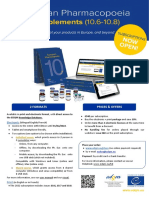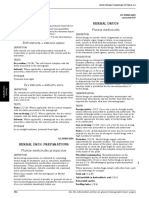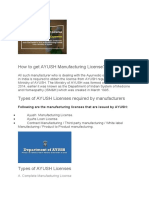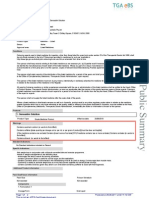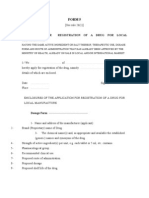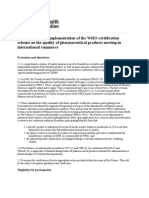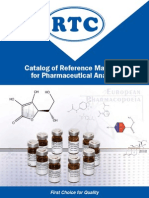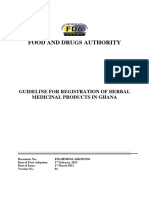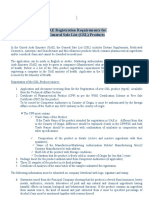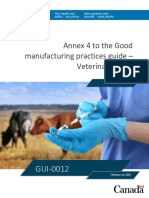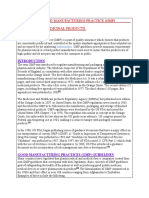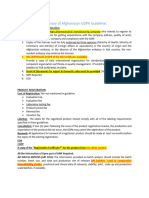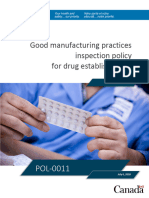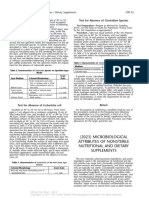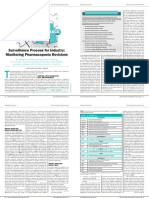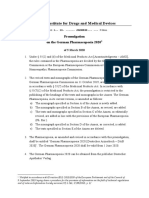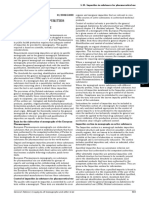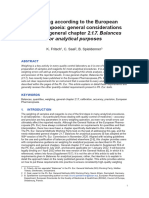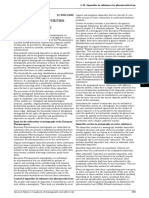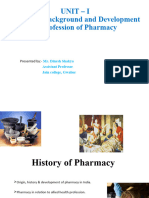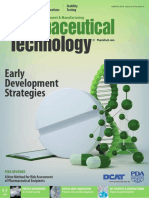Tgo 93 - 2017
Tgo 93 - 2017
Uploaded by
LuisSanabriaSaavedraCopyright:
Available Formats
Tgo 93 - 2017
Tgo 93 - 2017
Uploaded by
LuisSanabriaSaavedraOriginal Title
Copyright
Available Formats
Share this document
Did you find this document useful?
Is this content inappropriate?
Copyright:
Available Formats
Tgo 93 - 2017
Tgo 93 - 2017
Uploaded by
LuisSanabriaSaavedraCopyright:
Available Formats
Conforming with Therapeutic Goods
(Standard for Medicinal Cannabis)
(TGO 93) Order 2017
Version 1.2, May 2019
Therapeutic Goods Administration
Copyright
© Commonwealth of Australia 2019
This work is copyright. You may reproduce the whole or part of this work in unaltered form for your own personal use or, if
you are part of an organisation, for internal use within your organisation, but only if you or your organisation do not use the
reproduction for any commercial purpose and retain this copyright notice and all disclaimer notices as part of that
reproduction. Apart from rights to use as permitted by the Copyright Act 1968 or allowed by this copyright notice, all other
rights are reserved and you are not allowed to reproduce the whole or any part of this work in any way (electronic or
otherwise) without first being given specific written permission from the Commonwealth to do so. Requests and inquiries
concerning reproduction and rights are to be sent to the TGA Copyright Officer, Therapeutic Goods Administration, PO Box
100, Woden ACT 2606 or emailed to <tga.copyright@tga.gov.au>.
Conforming with TGO 93 (Standard for Medicinal Cannabis) Page 2 of 14
Version 1.2, May 2019
Therapeutic Goods Administration
Contents
What TGO 93 applies to _________________________ 5
Commencement________________________________ 5
Interpretation __________________________________ 5
European Pharmacopeia monographs _____________ 6
Source of active ingredients and cannabinoids______ 6
Decontamination _______________________________ 6
Identification __________________________________ 6
Chromatographic procedures _________________________________________________ 7
Chemical constituents of cannabis plant ------------------------------------------------7
Adulteration ___________________________________ 8
Tests _________________________________________ 8
How to validate tests ____________________________________________________________ 9
Cannabis plant tests _____________________________________________________________ 9
Sample size and preparation guidance---------------------------------------------------9
Specified tests ------------------------------------------------------------------------------------9
Every batch must comply ---------------------------------------------------------------------9
Alternative tests ------------------------------------------------------------------------------- 10
Additional tests -------------------------------------------------------------------------------- 10
Assay of active ingredients in the product ________________________________ 10
Active ingredient definition --------------------------------------------------------------- 10
Assay method ---------------------------------------------------------------------------------- 11
Stated content ---------------------------------------------------------------------------------- 11
Assay limits for various dosage forms -------------------------------------------------- 11
Other relevant standards _______________________ 12
Conforming with TGO 93 (Standard for Medicinal Cannabis) Page 3 of 14
Version 1.2, May 2019
Therapeutic Goods Administration
Unapproved medicinal cannabis products imported into and supplied/manufactured in
Australia must conform with Therapeutic Goods (Standard for Medicinal Cannabis) (TGO 93)
Order 2017 (TGO 93). TGO 93 is a standard that specifies minimum quality requirements for
medicinal cannabis products.
This guidance is for manufacturers and sponsors, to assist in ensuring medicinal cannabis
products conform with TGO 93. A Compliance checklist for sponsors is also available which
outlines the specific criteria and paperwork required for submission to the TGA.
Responsibility for products conforming with TGO 93 rests with the sponsor. It is an offence
under the Therapeutic Goods Act 1989, to import, export, or supply therapeutic goods that do not
conform to an applicable standard.
The TGA has developed a declaration form that must be completed for unapproved medicinal
cannabis products to declare that the product(s) conform to TGO 93. This should be
completed by the medicinal cannabis product manufacturer.
This form should be completed prior to the supply of any new unapproved medicinal cannabis
products in Australia, and also following any material change to medicinal cannabis products
(including cannabis plants used in their manufacture) that were the subject of a previous
declaration of conformity provided to the TGA where that change could have affected the quality
of the products.
The reason for requesting that the medicinal cannabis product manufacturer complete the
declaration form is that the person importing or supplying the unapproved medicinal cannabis
product(s) in Australia may not be the commercial sponsor of the good (for example, a medical
practitioner). The highly technical nature of TGO 93 means that this person may not be in a
position to declare that the product conforms to the standard. The manufacturer of the
medicinal cannabis product that has responsibility for quality control testing of the finished
product is best placed to declare that the medicinal cannabis product conforms to this standard.
The manufacturer of the medicinal cannabis product(s) should submit the completed form to the
person applying to access the medicinal cannabis product(s) through the available access
pathways.
Please note that although the cannabis plant used in the manufacture of the medicinal cannabis
product must meet the requirements of Schedule 1 of TGO 93, reduced or rotational testing of
the cannabis plant used in the manufacture of the product can be carried out provided that this
is justified on good manufacturing practice (GMP) grounds. For example, a manufacturer may be
able to justify reducing or not conducting pesticide testing if no pesticides are used in the
cultivation of the cannabis plant. Medicinal cannabis products, like any therapeutic good may be
subject to testing by the TGA at any time to ensure compliance with relevant standards.
For unapproved medicinal cannabis products to be accessed via:
• SAS and Authorised Prescriber: The medical practitioner is required to submit this form as
supportive documentation to the TGA with their notification or application, unless the
sponsor has already submitted the form to the TGA on the applicant’s behalf
• Clinical trials - CTN/CTX: The Australian clinical trial sponsor should complete the section
at the end of the form to include the name of the medicinal cannabis product(s) used in the
clinical trial as well as the TGA clinical trial application number and protocol number. The
clinical trial sponsor is then required to submit this form as supportive documentation to the
TGA with their application or notification, as applicable. In the case of a CTN involving the
use of a medicinal cannabis product, the clinical trial sponsor should submit this form via
email to clinical.trials@health.gov.au. In the case of a CTX involving the use of a medicinal
cannabis product, the clinical trial sponsor should submit this form as part of the CTX
application made to the TGA.
Conforming with TGO 93 (Standard for Medicinal Cannabis) Page 4 of 14
Version 1.2, May 2019
Therapeutic Goods Administration
What TGO 93 applies to
TGO 93 applies to:
any medicinal cannabis product imported into, exported from, or supplied in Australia
cannabis plant used in the manufacture of medicinal cannabis products (e.g. as an
ingredient or as a starting material for an extract used as an ingredient)
any other ingredients used in the manufacture of medicinal cannabis products, such as
excipients
steps and procedures carried out in the manufacture of medicinal cannabis products
TGO 93 does not apply to medicinal cannabis products:
imported by a member of a group of persons visiting Australia to participate in a national or
international sporting event, as described in item 4 of Schedule 5A to the Therapeutic Goods
Regulations 1990
imported by a member of the military forces of another country visiting Australia for
military training, as described in item 8 of Schedule 5A to the Therapeutic Goods
Regulations1990
imported by a medical practitioner or member of a medical team accompanying a critically
ill patient, as described in item 10 of Schedule 5A to the Therapeutic Goods Regulations 1990
imported by a member of a group of persons that includes the Head of Government or Head
of State of a foreign country and senior Government officials of that country, who are
visiting Australia on official business, as described in item 11 of Schedule 5A to the
Therapeutic Goods Regulations 1990
that are part of the medical supplies of a marine vessel or an aircraft visiting Australia for
use in treatment of a passenger or crew member, as described in item 12 of Schedule 5A to
the Therapeutic Goods Regulations 1990
that are described in item 1 of Schedule 5 to the Therapeutic Goods Regulations 1990
What TGO 93 applies to is defined in Section 6 of TGO 93.
Commencement
TGO 93 commences the day after it is registered on the Federal Register of Legislation (section 2
of TGO 93). All medicinal cannabis products imported, exported or supplied in Australia must
conform with TGO 93 from its commencement, unless you have been given a consent by the
Secretary.
Interpretation
The terms used in TGO 93 are consistent with therapeutic goods legislation, and may differ in
meaning from the terminology in narcotic drugs legislation (Narcotic Drugs Act 1967 and
Narcotic Drugs Regulation 2016).
‘Act’ is defined in section 4 of TGO 93 as the Therapeutic Goods Act 1989 and ‘Regulations’ as the
Therapeutic Goods Regulations 1990. Any term not defined in TGO 93 will usually take its
ordinary English meaning.
Conforming with TGO 93 (Standard for Medicinal Cannabis) Page 5 of 14
Version 1.2, May 2019
Therapeutic Goods Administration
European Pharmacopeia monographs
Section 7 of TGO 93 incorporates the requirements of the following general monograph of the
European Pharmacopoeia as being applicable to medicinal cannabis products and ingredients:
• Pharmaceutical Preparations (2619)
This general monograph encompasses the requirements of specific monographs of the European
Pharmacopeia for pharmaceutical raw materials (e.g. active ingredients, excipients) as well as
the requirements of general texts (e.g. Residual Solvents (5.4)) and other general monographs of
the European Pharmacopeia, including:
• Herbal Drugs (1433)
• Herbal Drug Preparations (765)
• Herbal Drug Extracts (765)
• Substances for Pharmaceutical Use (2034)
• dosage form monographs such as Oromucosal Preparations (1807)
Source of active ingredients and cannabinoids
All active ingredients and cannabinoids in medicinal cannabis products must be manufactured
from the cannabis plant only (section 8 of TGO 93). This means that medicinal cannabis
products cannot contain:
the synthetic form of any cannabinoid [including, for example, the synthetic form of
tetrahydrocannabinol (THC) (known as dronabinol)]
active ingredients from any source other than the cannabis plant
Decontamination
If you decontaminate the cannabis plant—for example, by using gamma irradiation to reduce the
microbial load—you must ensure that this does not adversely affect the quality of the medicinal
cannabis product (section 9(a) of TGO 93).
Do not use ethylene oxide to decontaminate the cannabis plant (section 9(b) of TGO 93). This is
in line with current guidance on the quality of herbal medicinal products. For more information,
see:
• Guideline on quality of herbal medicinal products1/traditional herbal medicinal
products(EMA/CPMP/QWP/2819/00 Rev. 2)
Identification
You must positively identify the cannabis plant used in the manufacture of medicinal cannabis
products and differentiate it from potential adulterants and substitutes using each of the
following identification methods (section 10 of TGO 93):
• macroscopic examination
• microscopic examination
Conforming with TGO 93 (Standard for Medicinal Cannabis) Page 6 of 14
Version 1.2, May 2019
Therapeutic Goods Administration
• chromatographic procedures
These identification methods must be suitably validated and performed on every batch of the
cannabis plant.
TGA guidance Identification of herbal materials and extracts relates to the identification of plant
materials, such as cannabis plant, that do not have a monograph in a pharmacopoeial standard.
This guidance specifies that the macroscopic, microscopic, and chemical characteristics of the
plant should be compared against either:
• an authenticated reference specimen
OR
• the descriptions given in an authoritative literature source such as:
– the United Nations Office of Drugs and Crime website: Recommended methods for the
identification and analysis of cannabis and cannabis products
– the American Herbal Pharmacopoeia monograph Cannabis inflorescence
Further guidance on identification testing is given in United States Pharmacopeia-National
Formulary General Chapter <563> Identification of articles of botanical origin.
Chromatographic procedures
Chromatographic procedures are chemical tests that determine whether the characteristic
chemical constituents of the plant are present in the plant.
Examples of chromatographic procedures include:
• high-performance liquid chromatography
• thin-layer chromatography
• gas chromatography
Tests may involve one or more chromatographic procedures. For example, the British
Pharmacopoeia for Holy Basil Leaf (the dried leaves of Ocimum tenuiflorum) stipulates the use of
macroscopic and microscopic examination as well as two thin-layer chromatography test
procedures for the identification of the plant.
Chemical constituents of cannabis plant
Recognised chemical constituents of the cannabis plant include cannabinoids, such as
tetrahydrocannabinols, and terpenes.
Examples of tetrahydrocannabinols include:
• delta-9-tetrahydrocannabinol (also commonly referred to as tetrahydrocannabinol, delta-
9THC, or THC)
• tetrahydrocannabinolic acid (THC-acid)
• delta-8-THC
• tetrahydrocannabivarin (THCV or THV)
• 11-hydroxy-delta-9-THC
Conforming with TGO 93 (Standard for Medicinal Cannabis) Page 7 of 14
Version 1.2, May 2019
Therapeutic Goods Administration
Examples of other cannabinoids include:
• cannabidiol (CBD)
• cannabidiolic acid (CBD-acid)
• cannabichromene (CBC)
• cannabinol (CBN)
Examples of terpenes include:
• beta-caryophyllene
• geraniol
• alpha-humulene
• limonene
• linalool
• myrcene
Some cannabinoids such as THC and CBD are unique to the Cannabis genus.
Gas chromatography can be used to confirm that cannabinoids and other
characteristic terpenes are present in the cannabis plant.
Adulteration
Do not adulterate the formulated medicine or any of its ingredients with undeclared substances.
Tobacco, calamus and synthetic cannabinoids are notable examples of adulterants (section 11 of
TGO 93).
The motivation for adulterating a product is irrelevant—the presence of any substance
extraneous to the formulation (such as undeclared substances)—will be considered to amount
to adulteration for the purposes of TGO 93.
‘Incidental minor excipients’ are not considered adulterants. These are defined in section 4 of
TGO 93 as:
• an excipient or processing aid in the manufacture of ingredients for medicinal
cannabisproducts
OR
• a processing aid in the manufacture of medicinal cannabis products
Tests
TGO 93 specifies tests and assay limits in section 12 of TGO 93.
Conforming with TGO 93 (Standard for Medicinal Cannabis) Page 8 of 14
Version 1.2, May 2019
Therapeutic Goods Administration
How to validate tests
For guidance on the principles and practice of validating tests:
• ICH Harmonised Tripartite Guideline Validation of Analytical Procedures: Text
andMethodology Q2 (R1).
Cannabis plant tests
The cannabis plant you use must comply with the limits specified in Schedule 1, in addition to
being positively identified as described in section 10 of TGO 93. The limits for the parameters
apply on a dried basis, with the exception of the test for foreign matter). It may be appropriate
to carry out additional tests to those specified in TGO 93 in certain circumstances.
Sample size and preparation guidance
Choose a sample size that is representative of the batch. For guidance on sample sizes and how
to prepare herbal plant material for analysis, see:
European Pharmacopoeia method of analysis Herbal Drugs: Sampling and Sample Preparation
(2.8.20)
Specified tests
You must determine whether the cannabis plants used to manufacture the medicinal cannabis
products meet the requirements of Schedule 1.
The following parameters are specified in Schedule 1:
1. aflatoxins
2. foreign matter
3. heavy metals (arsenic, cadmium, lead and mercury)
4. ochratoxin A
5. pesticides
6. total ash
The tests in Schedule 1 are standard pharmacopoeial tests applied to the cannabis plant used in
the manufacture of medicinal products. For more information, see:
• European Pharmacopoeia general monograph Herbal Drugs (1433)
• Guidance on Specifications: Test Procedures and Acceptance Criteria for Herbal Substances,
Herbal Preparations and Herbal Medicinal Products/Traditional Herbal Medicinal
Products(CPMP/QWP/2820/00 Rev 2).
Every batch must comply
Every batch of your medicinal cannabis product must be manufactured from cannabis plants
that meet the requirements of Schedule 1. Generally, we expect all tests to be carried out on a
routine basis to ensure that if a sample was tested by the TGA it would meet TGO 93
requirements.
Conforming with TGO 93 (Standard for Medicinal Cannabis) Page 9 of 14
Version 1.2, May 2019
Therapeutic Goods Administration
However, in accordance with good manufacturing practice (GMP) considerations, you may
perform reduced or rotational testing for non-critical tests provided that you are able to justify
this reduced or rotational testing. For example, you may be able to justify reducing or not
conducting pesticide testing if no pesticides are used in the cultivation of the cannabis plant.
Alternative tests
You do not have to use the methods specified in Schedule 1 to test the cannabis plant. You could
use:
• equivalent methods in established pharmacopoeia, including the United States
Pharmacopoeia-National Formulary
• suitably validated in-house or literature (non-pharmacopoeial) tests that are suitable for the
intended purpose
However, in the event of a dispute, the methods of analysis specified in TGO 93 are the official
methods.
Additional tests
In addition to testing the parameters specified in Schedule 1, consider performing additional
tests on the cannabis plant from the general monograph on Herbal Drugs (1433), where such
tests are warranted.
For example:
• water or loss on drying:
– Consider performing tests for the cannabis plant in relation to water or loss on drying
with appropriate limits to ensure that the cannabis plant does not contain excessive
moisture that could facilitate the growth of microorganisms
• Radioactivity
– Consider performing tests for the cannabis plant in relation to radioactive
contamination if the plant is grown in an area with potential for radioactive
contamination, e.g. the Chernobyl region.
Assay of active ingredients in the product
You need to measure the contents of the active ingredients. The actual quantity of active
ingredients must be within a specified range of the stated quantity [section 12(2) of TGO 93].
This range applies at both release and end of shelf-life.
Active ingredient definition
An active ingredient is a therapeutically active component in the medicine’s final formulation
that is responsible for its physiological or pharmacological action (section 4 of TGO 93). In
addition, the following ingredients are considered to be active ingredients in section 4(2) of TGO
93 for the purposes of TGO 93:
• any tetrahydrocannabinol (including any corresponding acid) greater than or equal to 1.0%
w/w or w/v of the product
• any other cannabinoids (including any corresponding acid) greater than or equal to 2.0%
w/w or w/v of the product
Conforming with TGO 93 (Standard for Medicinal Cannabis) Page 10 of 14
Version 1.2, May 2019
Therapeutic Goods Administration
Corresponding acids
The term ‘corresponding acid’ is used because some cannabinoids such as THC and CBD
ordinarily exist in the cannabis plant in the form of their corresponding acid, namely THC-acid
and CBD-acid respectively. These acids form THC and CBD as a result of decarboxylation during
storage or heating.
It is common practice to express the contents of cannabinoids in the cannabis plant as the total
of cannabinoid and corresponding acid. For example, total THC is the sum of THC and THC-acid
and total CBD is the sum of CBD and CBD-acid. The assay should be performed with reference to
these total sums.
Assay method
No particular test method is prescribed for calculating the average content of each active
ingredient in accordance with section 12(2) of TGO 93. The assay method you use will depend
on the active ingredient, the dosage form and the formulation of the product. You can use any
suitably validated test method.
Examples of literature assay methods can be found in:
• Monograph Cannabis Flos Version 7.1 (November 28, 2014)_40953, Dutch Office ofMedicinal
Cannabis
• Recommended methods for the identification and analysis of cannabis and cannabis
products, United Nations Office on Drugs and Crime.
Stated content
The assay limits are specified in relation to the stated content of each active ingredient. ‘Stated
content’ is defined in section 4 of TGO 93. ‘Stated content’ means the quantity or proportion of
each active ingredient:
• specified on the label, if we have approved an application under section 25 of the
Therapeutic Goods Act 1989
• disclosed in an application made under section 19 of the Therapeutic Goods Act 1989,
whether or not the quantity or proportion is specified on the label
• disclosed in an application made under regulation 12A of the Regulations, whether or not
the quantity or proportion is specified on the label
• purported to be present in a medicinal cannabis product that is dispensed, or
extemporaneously compounded, for a particular person for therapeutic application to that
person, in the manner mentioned in item 6 of Schedule 5 to the Therapeutic Goods
Regulations 1990
• notified to be present for the purpose of clinical trials as described in item 3 of Schedule
5Ato the Therapeutic Goods Regulations 1990
Assay limits for various dosage forms
You need to test the contents of the active ingredients in medicinal cannabis products. The assay
limits for these tests are specified at section 12(2) of TGO 93 and will differ depending on the
dosage form of products, specifically:
• herbal final form
• tablets and capsules
Conforming with TGO 93 (Standard for Medicinal Cannabis) Page 11 of 14
Version 1.2, May 2019
Therapeutic Goods Administration
• other dosage forms
Herbal dosage form
When the product is in herbal final form (section 12(2)(a) of TGO 93), such as sachets of
cannabis leaf material, each active ingredient, together with any corresponding acid, in a
representative sample must be in the range of 80.0–120.0% of the stated content of that active
ingredient.
Tablets or capsules
When the product is in tablet or capsule form (section 12(2)(b) of TGO 93), the average content
of each active ingredient, together with any corresponding acid, as determined from a pooled
sample of not fewer than 20 tablets or capsules, must be in the range of 90.0–110.0% of the
stated content of that active ingredient.
Tablets or capsules on the ARTG
Medicinal cannabis products in tablet or capsule form that are registered on
the ARTG must comply with the assay limits in TGO 101, which are tighter than
those in TGO 93 (section 12 note).
Other dosage forms
For any other dosage form (for example, oromucosal spray) (section 12(2)(c) of TGO 93), the
content of each active ingredient, together with any corresponding acid, in a representative
sample must be in the range of 90.0–110.0% of the stated content of the active ingredient.
Other relevant standards
In addition to TGO 93, medicinal cannabis products must also conform with any other applicable
therapeutic goods orders.
You must comply with any applicable Therapeutic Goods Order.
Examples of applicable therapeutic goods orders include:
• for all medicines: Therapeutic Goods Order No. 77 Microbiological Standards for Medicines
• for tablets and capsules registered on the ARTG: Therapeutic Goods (Standard for Tablets,
Capsules and Pills) (TGO 101) Order 2019
Conforming with TGO 93 (Standard for Medicinal Cannabis) Page 12 of 14
Version 1.2, May 2019
Therapeutic Goods Administration
Version history
Version Description of change Author Effective date
V1.0 Original publication Laboratories Branch; March 2017
Pharmacovigilance and
Special Access Branch;
Regulatory Guidance
Team
V1.1 Updated to clarify content Pharmacovigilance and July 2018
Special Access Branch
V1.2 Updated to amend name Pharmacovigilance and May 2019
Special Access Branch
Conforming with TGO 93 (Standard for Medicinal Cannabis) Page 13 of 14
Version 1.2, May 2019
Therapeutic Goods Administration
PO Box 100 Woden ACT 2606 Australia
Email: info@tga.gov.au Phone: 1800 020 653 Fax: 02 6203 1605
https://www.tga.gov.au
D17-76046
You might also like
- Bp2023 - Volume IDocument1,438 pagesBp2023 - Volume IGIGI ROCIO HARO MARIÑOS88% (8)
- European Pharmacopoeia (Ph. Eur.) 10th Edition - RenewalsDocument3 pagesEuropean Pharmacopoeia (Ph. Eur.) 10th Edition - RenewalsYaseminNo ratings yet
- PH Eur 1433 Herbal DrugsDocument2 pagesPH Eur 1433 Herbal DrugsLuisSanabriaSaavedra0% (1)
- PH Eur 2.8.20. Herbal Drugs - Sampling and Sample PreparationDocument2 pagesPH Eur 2.8.20. Herbal Drugs - Sampling and Sample PreparationLuisSanabriaSaavedraNo ratings yet
- Ayush LicenseDocument7 pagesAyush LicenseParas MittalNo ratings yet
- Who Certification SchemeDocument34 pagesWho Certification SchemeJnanankur BhowmikNo ratings yet
- GMP in Pharmaceutical Industry: Global cGMP & Regulatory ExpectationsFrom EverandGMP in Pharmaceutical Industry: Global cGMP & Regulatory ExpectationsRating: 5 out of 5 stars5/5 (2)
- Europe Medical Cannabis Regulation Jul 2019Document55 pagesEurope Medical Cannabis Regulation Jul 2019LuisSanabriaSaavedra100% (1)
- Guidance Regulation Listed Disinfectants AustraliaDocument21 pagesGuidance Regulation Listed Disinfectants AustraliaAshraf ElmougiNo ratings yet
- Bureau Circular 5 S 1997Document39 pagesBureau Circular 5 S 1997mrk_rlndNo ratings yet
- Tar Ausguid20210201 Tga Risk ManagementDocument12 pagesTar Ausguid20210201 Tga Risk ManagementLorenaNo ratings yet
- 203 - Unit 3Document28 pages203 - Unit 3muskanhavaldar33No ratings yet
- Disinfectants Evaluation GuidelinesDocument44 pagesDisinfectants Evaluation Guidelinesamerican_guy10No ratings yet
- Medical Device Regulatory Requirements FDocument26 pagesMedical Device Regulatory Requirements Fmd edaNo ratings yet
- DO Guidance IE ATP-ENDocument46 pagesDO Guidance IE ATP-ENwingcwanNo ratings yet
- Supplier Assessment Approval and Qualification Listed and Complementary MedicinesDocument14 pagesSupplier Assessment Approval and Qualification Listed and Complementary MedicinesPurwaning Nugroho WNo ratings yet
- Drug Registration Requirements in SudanDocument21 pagesDrug Registration Requirements in Sudanjai murugeshNo ratings yet
- Orgional Guideline For Quality Agreemnt in Contract Manufacturing With Track Change Comment by ABDELADocument34 pagesOrgional Guideline For Quality Agreemnt in Contract Manufacturing With Track Change Comment by ABDELAAbdela KassoNo ratings yet
- SensaSlim TGA Summary For Australian Register of Therapeutic GoodsDocument2 pagesSensaSlim TGA Summary For Australian Register of Therapeutic GoodsPaul GallagherNo ratings yet
- Nicotine Vaping Products and Vaping Devices September 2021 - 0 - 0Document33 pagesNicotine Vaping Products and Vaping Devices September 2021 - 0 - 0Nicole TravissNo ratings yet
- Form 5Document4 pagesForm 5Munir DayaniNo ratings yet
- CoppDocument21 pagesCoppSanjana ChoukseNo ratings yet
- QA Version 3 - Aseptic Manip UpdatesDocument36 pagesQA Version 3 - Aseptic Manip UpdatesAhmed NabilNo ratings yet
- WHO - Guidelines On The Implementation of The WHO Certification Scheme On The Quality of Pharmaceutical Products Moving in International CommerceDocument9 pagesWHO - Guidelines On The Implementation of The WHO Certification Scheme On The Quality of Pharmaceutical Products Moving in International CommerceDonny LoNo ratings yet
- Ongoing Stability Testing Listed Complementary MedicinesDocument13 pagesOngoing Stability Testing Listed Complementary Medicinesdarren.dziedziczakNo ratings yet
- PPB Guidance Record Keeping LM WDL ATP enDocument18 pagesPPB Guidance Record Keeping LM WDL ATP enwingcwanNo ratings yet
- CDSCO GuidanceForIndustryDocument181 pagesCDSCO GuidanceForIndustrydeepakmaramwarNo ratings yet
- PPB Guidance Reg ATP EnDocument28 pagesPPB Guidance Reg ATP EnAmy MakNo ratings yet
- Guidance For IndustryBiologicals3Document1 pageGuidance For IndustryBiologicals3ksvnewdelhiNo ratings yet
- General Requirements For The Labelling of Medicines: Therapeutic Goods Act 1989Document35 pagesGeneral Requirements For The Labelling of Medicines: Therapeutic Goods Act 1989Darryl ViljoenNo ratings yet
- Guidelines For Renewal of Registration of A Pharmaceutical ProductDocument10 pagesGuidelines For Renewal of Registration of A Pharmaceutical ProductWasswa SolomonNo ratings yet
- Australia Post Market Activity GuidelinesDocument31 pagesAustralia Post Market Activity Guidelinesspenceblack7999No ratings yet
- RTC Pharma07CatalogWebDocument168 pagesRTC Pharma07CatalogWebnophadonNo ratings yet
- Pooja ReviewDocument6 pagesPooja Reviewdr.pragna infoplusNo ratings yet
- Form 5-ADocument4 pagesForm 5-AAbdullahAbroNo ratings yet
- Guidelines For Imported Herbal Medicinal Products - R0 - FinalDocument52 pagesGuidelines For Imported Herbal Medicinal Products - R0 - FinalWasswa SolomonNo ratings yet
- The Practice of Regulatory AffairsDocument42 pagesThe Practice of Regulatory AffairsCool AnnieNo ratings yet
- 7.01 CAMs QSE Dec13 v2 1Document48 pages7.01 CAMs QSE Dec13 v2 1dutoitlouwNo ratings yet
- Appendix 13a - Part A - Checklist On Dossier Requirements For Miv 1 VariationDocument21 pagesAppendix 13a - Part A - Checklist On Dossier Requirements For Miv 1 VariationachungNo ratings yet
- MHRA Questions and Answers For Specials Manufacturer's Con326474 PDFDocument44 pagesMHRA Questions and Answers For Specials Manufacturer's Con326474 PDFSharma PokkuluriNo ratings yet
- Guideline For Registration of Herbal Medicinal. ProductsDocument9 pagesGuideline For Registration of Herbal Medicinal. ProductsDay 2 Day Motivation TVNo ratings yet
- UAE Registration Requirements For General Sale List (GSL) ProductsDocument2 pagesUAE Registration Requirements For General Sale List (GSL) Productspandita bumikalimasadaNo ratings yet
- Aut g0037 Guide To Registration of Homeopathic Medicinal Products v4Document26 pagesAut g0037 Guide To Registration of Homeopathic Medicinal Products v4u72177615No ratings yet
- EN - GUI-0012 - Annex 4 To The Good Manufacturing Guide - Veterinary DrugsDocument29 pagesEN - GUI-0012 - Annex 4 To The Good Manufacturing Guide - Veterinary DrugsliacobaccioNo ratings yet
- Unit 3 Notes DRADocument22 pagesUnit 3 Notes DRAOyshi RaoNo ratings yet
- MCAZ Amendment GuidelinesDocument45 pagesMCAZ Amendment GuidelinesSuma GuruNo ratings yet
- Pharma GMP GuidanceDocument155 pagesPharma GMP GuidanceDinesh SenathipathiNo ratings yet
- AnnexIIRecommendationsbyHOTCCommittee06 11 18Document6 pagesAnnexIIRecommendationsbyHOTCCommittee06 11 18Bilal AbbasNo ratings yet
- Afg Guidelines 1Document17 pagesAfg Guidelines 1pharmacistwareeshaNo ratings yet
- Finalized Promotion Control Guideline 2nd Edition PDFDocument35 pagesFinalized Promotion Control Guideline 2nd Edition PDFElisha ThompsonNo ratings yet
- Pesticide Regulatory PoliciesDocument25 pagesPesticide Regulatory PoliciesAnonymous ZKJZKuxm0% (1)
- Australian Public Assessment Report For Sofosbuvir: Proprietary Product Name: Sovaldi Sponsor: Gilead Sciences Pty LTDDocument76 pagesAustralian Public Assessment Report For Sofosbuvir: Proprietary Product Name: Sovaldi Sponsor: Gilead Sciences Pty LTDCH NarimaneNo ratings yet
- Common Technical Document (CTD) For Registration of Human Drugs Module 1: Administrative Part Section Sub-Section HeadingDocument8 pagesCommon Technical Document (CTD) For Registration of Human Drugs Module 1: Administrative Part Section Sub-Section HeadingFarhan aliNo ratings yet
- Guideline For Licensing of Premises For Manufacturing Medical DevicesDocument19 pagesGuideline For Licensing of Premises For Manufacturing Medical Devicesgodsway.dzikunuNo ratings yet
- Guideline For Repackaging and Labelling of MedicinesDocument18 pagesGuideline For Repackaging and Labelling of MedicinestesteNo ratings yet
- Summary of Afghanistan GDPA GuidelineDocument3 pagesSummary of Afghanistan GDPA GuidelinechanderjagdishNo ratings yet
- CA2 Leupron Ans KunalDocument12 pagesCA2 Leupron Ans Kunalvaishanavib2000No ratings yet
- Pol-0011 enDocument20 pagesPol-0011 enliacobaccioNo ratings yet
- _Ethopia_Food_and_Drug_Authority_1681652810Document19 pages_Ethopia_Food_and_Drug_Authority_1681652810aftabanwar.7777No ratings yet
- The FDA and Worldwide Current Good Manufacturing Practices and Quality System Requirements Guidebook for Finished PharmaceuticalsFrom EverandThe FDA and Worldwide Current Good Manufacturing Practices and Quality System Requirements Guidebook for Finished PharmaceuticalsNo ratings yet
- Usp 35 - (731) Loss On DryingDocument2 pagesUsp 35 - (731) Loss On DryingLuisSanabriaSaavedraNo ratings yet
- Test For Absence of Clostridium SpeciesDocument4 pagesTest For Absence of Clostridium SpeciesLuisSanabriaSaavedraNo ratings yet
- PH Eur Index 9,1 2 (2016)Document34 pagesPH Eur Index 9,1 2 (2016)LuisSanabriaSaavedraNo ratings yet
- Ph. Eur 5.1.8 - Microbiolgical Quality Herbal Medicine Products For Oral UseDocument1 pagePh. Eur 5.1.8 - Microbiolgical Quality Herbal Medicine Products For Oral UseLuisSanabriaSaavedraNo ratings yet
- CU Inspection Regulation: Annex 16Document30 pagesCU Inspection Regulation: Annex 16LuisSanabriaSaavedraNo ratings yet
- General NoticesDocument7 pagesGeneral Notices777xxx88No ratings yet
- RTC Pharma07CatalogWebDocument168 pagesRTC Pharma07CatalogWebnophadonNo ratings yet
- WHO Valerian MonographDocument6 pagesWHO Valerian MonographcslacikaNo ratings yet
- Surveillance Process For Industry: Monitoring Pharmacopoeia RevisionsDocument7 pagesSurveillance Process For Industry: Monitoring Pharmacopoeia RevisionsLinh NguyenNo ratings yet
- Draft Guidance For Pharmacists On Extemporaneous Dispensing For ConsultationDocument10 pagesDraft Guidance For Pharmacists On Extemporaneous Dispensing For Consultationdabaeshetu5No ratings yet
- Federal Institute For Drugs and Medical Devices: Promulgation On The German Pharmacopoeia 2020Document3 pagesFederal Institute For Drugs and Medical Devices: Promulgation On The German Pharmacopoeia 2020Emmanouil TsampalasNo ratings yet
- Draft Reflection Paper Markers Used Quantitative Qualitative Analysis Herbal Medicinal Products - enDocument6 pagesDraft Reflection Paper Markers Used Quantitative Qualitative Analysis Herbal Medicinal Products - enAshy CooperNo ratings yet
- 5.10. Control of Impurities in Substances For Pharmaceutical Use 51000eDocument4 pages5.10. Control of Impurities in Substances For Pharmaceutical Use 51000eAna MariaNo ratings yet
- Technical Guide For The Elaboration of Monographs EDQMDocument72 pagesTechnical Guide For The Elaboration of Monographs EDQMppiccoliniNo ratings yet
- Resource Technology CorporationDocument112 pagesResource Technology CorporationAnnurfa HikariNo ratings yet
- Contents of Supplement 8-5Document2 pagesContents of Supplement 8-5Ahmmad W. MahmoodNo ratings yet
- Codex Anthroposophical PharmacyDocument156 pagesCodex Anthroposophical PharmacyDavid Vandevoort100% (1)
- British Pharmacopoeia 2022 BP 2022 - Volume VDocument1,202 pagesBritish Pharmacopoeia 2022 BP 2022 - Volume VRakesh RauniyarNo ratings yet
- EP 2.1.7 Balances For Analytical PurposeDocument9 pagesEP 2.1.7 Balances For Analytical PurposePaolo PiccoliniNo ratings yet
- 5.10. Control of Impurities in Substances For Pharmaceutical Use PDFDocument3 pages5.10. Control of Impurities in Substances For Pharmaceutical Use PDFdenisaNo ratings yet
- BS Analytical Chemistry NotesDocument27 pagesBS Analytical Chemistry NotesAmna NasirNo ratings yet
- Veterinaria PDFDocument435 pagesVeterinaria PDFSara SánNo ratings yet
- Homeopathic Medicines (HM) Labelling StandardDocument4 pagesHomeopathic Medicines (HM) Labelling StandardMiroslav IlicNo ratings yet
- Unit - I Historical Background and Development of Profession of PharmacyDocument33 pagesUnit - I Historical Background and Development of Profession of PharmacyDinesh ShakyaNo ratings yet
- Acceptance Criteria of Balance WP - USP41 - Weighing - ENDocument16 pagesAcceptance Criteria of Balance WP - USP41 - Weighing - ENnayan700No ratings yet
- Early Development Strategies: Lab Operations Stability Testing Quality AgreementsDocument9 pagesEarly Development Strategies: Lab Operations Stability Testing Quality AgreementsKolisnykNo ratings yet
- Consult - Quality Qualite Eng PDFDocument44 pagesConsult - Quality Qualite Eng PDFFaisal AbbasNo ratings yet
- How To Read This TableDocument2 pagesHow To Read This TableOmarNo ratings yet
- EANM Guideline On The Validation of Analytical MetDocument29 pagesEANM Guideline On The Validation of Analytical MetPedro978No ratings yet
- 2 Sanz BisetDocument31 pages2 Sanz BisetObagunwaTemitopeDamilareNo ratings yet
- Quality of medicines questions and answers(中英文)Document52 pagesQuality of medicines questions and answers(中英文)meiNo ratings yet
- 0711 0900 PL EU Regulations For MedicinesDocument22 pages0711 0900 PL EU Regulations For MedicinesMoldoveanu AlionaNo ratings yet

